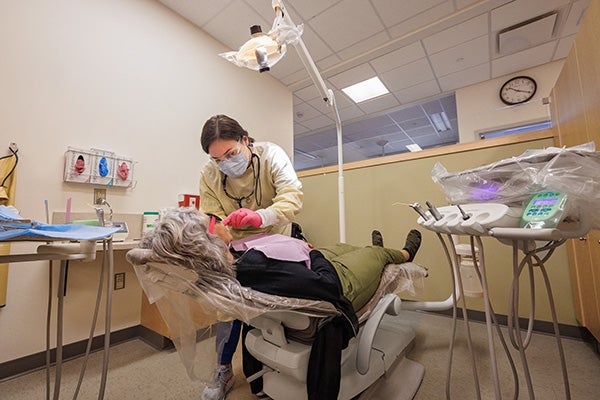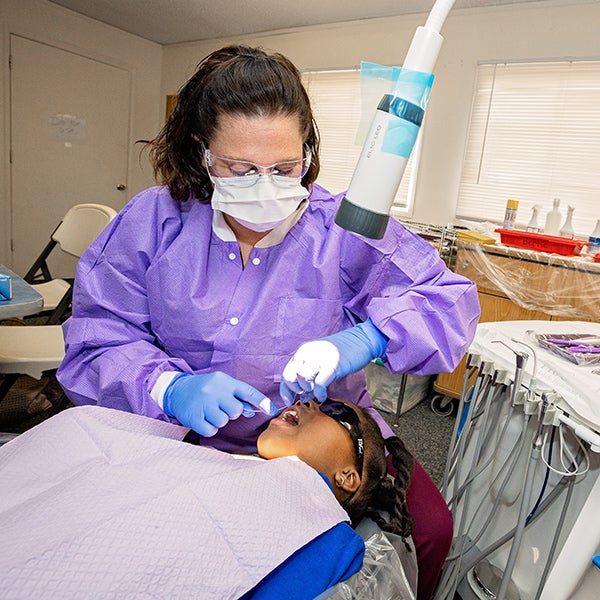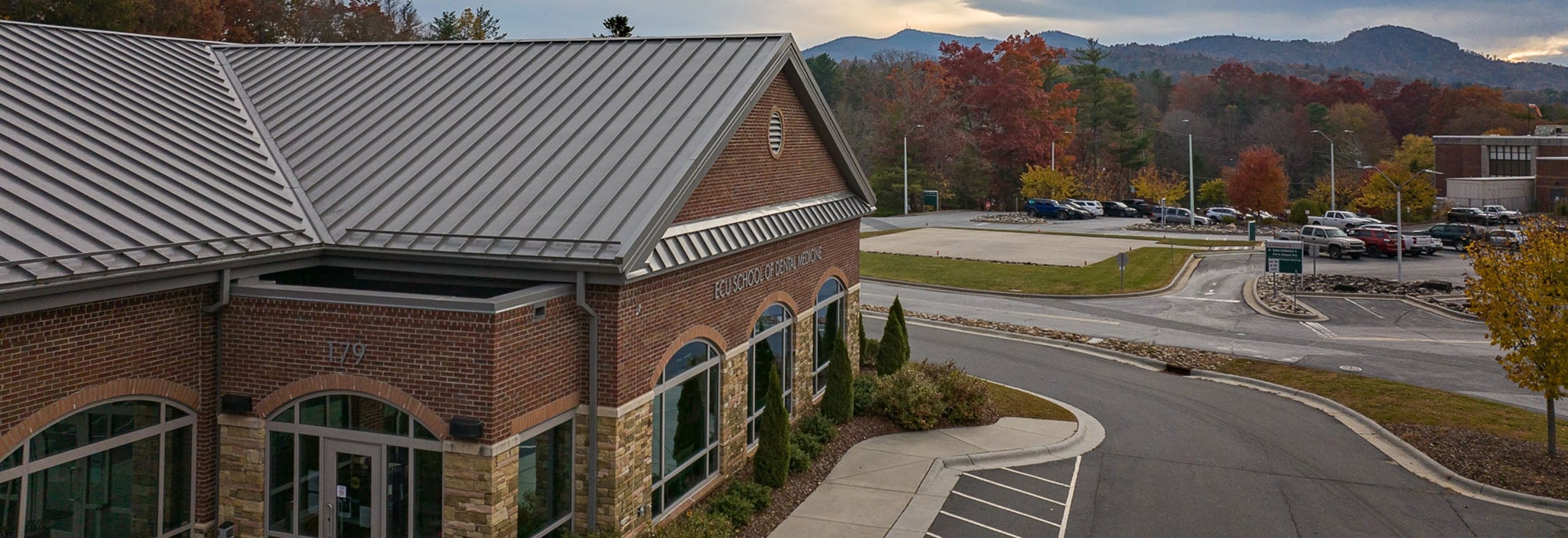RURAL DENTAL INNOVATION
ECU dental school’s innovation transforms oral health care in rural North Carolina
Mount Airy, North Carolina, sits three miles south of the Virginia state line, a community of 10,000 so prototypical of Southern charm that it’s accepted as the basis for the town of Mayberry from “The Andy Griffith Show.”
Surry County — where Mount Airy is located — is considered a dental health professional shortage area, along with the rest of North Carolina, according to the Health Resources and Services Administration.
When Dr. Laura Mercer, a native of Mount Airy, graduated from East Carolina University’s School of Dental Medicine in 2019, she headed back to her hometown to practice — a native daughter returning to care for the community that raised her.
“It’s such a humbling experience to be able to serve the community that helped shape me into who I am today,” said Mercer, a dentist at James H. Wells, DDS. “I love being able to connect instantly with my patients when I tell them I am from Mount Airy. It’s a great first step to building lifelong relationships with my patients.”

Fourth-year dental student Kari Wordsworth provides care to a patient during her rotation at the School of Dental Medicine’s community service learning center in Spruce Pine.
Mercer is a prime example of the dental school’s mission to develop leaders with a passion to care for the underserved and improve the health of North Carolina and the nation. In the past four years, the School of Dental Medicine has won two national awards for its innovative model of education and patient care — one for placing eight community service learning centers (CSLCs) in communities across the state, and the other for its commitment to advancing social mission and exploring ways to better serve rural parts of the state.
The school’s earliest vision — when the idea of a dental school in Greenville was still picking up steam in the 2000s — included a promise to educate new dentists who were naturally inclined to remain in North Carolina and practice in rural and underserved parts of the state. The school’s system of CSLCs was a built-in part of that mission that soon became tangible. More than a decade later, the model has yielded solid results and credibility to the school’s commitment to immerse students in the challenges and rewards of practicing in rural locations.
Those relationships are built from the ground up before students leave the ECU School of Dental Medicine.
Fourth-year dental students spend nine weeks in three different CSLCs across the state, for 27 weeks of experience living and working in communities whose residents face a plethora of disparities, from financial hardships to geographical access — in addition to other obstacles in the way of care for many socially disadvantaged patients.
The CSLCs, campus and hospital clinics, and other locations have enabled the school’s faculty, students and residents to care for more than 92,000 patients from all 100 of the state’s counties. Close to 90% of the school’s more than 400 alumni are practicing in North Carolina.
“We envisioned, very early on, a model of education and patient care that would not only address the oral health care gap in North Carolina but also instill in future dentists a desire to put their talents to work in rural and remote communities,” said Dr. Greg Chadwick, dean of the ECU School of Dental Medicine. “We will continue to create pathways to oral health care in rural communities as we encourage our graduates to practice within reach of all North Carolina patients who need them.”
From the Appalachians to the Atlantic
As part of her dental school experience, fourth-year dental student Kari Wordsworth has lived and worked in the communities of Spruce Pine in the mountains and Brunswick County in the southeast corner of the state. Two of the school’s CSLCs are in those areas — the others are in Ahoskie, Davidson County, Elizabeth City, Lillington, Robeson County and Sylva.
“It’s empowering to physically be living out our dental school mission,” Wordsworth said. “Getting to be a part of what our school is doing — providing a sustainable model to provide care to these rural areas where otherwise they may not have access to care near them has been so rewarding.”

The School of Dental Medicine’s faculty, staff, students and residents participate in programs like the Bertie County School Based Oral Prevention Program that are put in place in rural communities with few or no practicing dentists.
Caring for patients on opposite ends of the state has shown Wordsworth that while dental patients can face many of the same challenges and socioeconomic barriers to care, their rural communities are different in many ways — presenting additional considerations when exploring the best route of care.
“I have better understood that different patient populations have different needs, and they can become pretty unique,” she said. “Here in Spruce Pine, we see a lot of kids, whereas in my time in Brunswick (County), I saw a lot of folks who have retired. Ahoskie had a lot of special needs patients.”
That exposure to different populations can contribute to graduates’ decisions to practice where they are needed most.
“In North Carolina, where all 100 counties are health professional shortage areas, no matter where students go there are going to be underserved populations that they need to know about and understand how to best get them in for care,” said Dr. T. Rob Tempel, the dental school’s associate dean for extramural clinical practices. “What’s unique about ECU’s model is our students live for 27 weeks out in these rural communities, and the teammates they work with live in these rural areas. The students get to build relationships with them and see what’s important to them and their families and friends in the rural areas.”
In addition to the CSLC communities, students, faculty, staff and residents are spending time in counties with few or no practicing dentists. The Bertie County School Based Oral Prevention Program, a program based on a grant from the Duke Endowment, works to provide long-term oral health care and build positive dental hygiene habits in school children in that community. A similar program is slated to kick off in Jones County early next year.
Earlier this year, the School of Dental Medicine opened a small clinic in Hyde County to offset the lack of access for people from the region and to strengthen the ties between oral health and primary care.
“What really makes us unique is we include the communities in the conversation in order to build sustainable solutions for us to keep the promise that we have with the state for our dental school, by getting feedback from the stakeholders, including them in developing solutions and everybody’s challenges and opportunities are understood,” Tempel said. “Hyde County is a perfect example of that; we involved that community and we’re continuing to make a difference.”
Tempel added that trust is a key factor in reaching rural and underserved communities.
“It’s also really important to understand the value of trust and what you need to do to establish that with the people in these communities to be successful in meeting their needs,” he said. “We have to be part of the primary care system — and in rural areas, that’s amplified. Everyone has to work together to be successful in getting through these barriers to care.”
Reaching out and leaning in
Three years into her career, Mercer feels secure in her academic and clinical foundation built at ECU.
“The School of Dental Medicine helped me succeed as a dentist in a rural area of the state by making me a well-rounded professional,” she said. “The program did a great job of making sure I became competent in all areas of dentistry so that I could provide most services to patients without having to send them miles away.”
After earning a degree in molecular biology in 2016 from ECU, Dr. Darian Askew graduated from the dental school in 2022 and practices in Roanoke Rapids. Originally from Hertford County, Askew completed a rotation at the CSLC-Ahoskie. He credits the dental school with teaching him how to interact with people from different backgrounds, cultures and places.
“I don’t believe I would be exposed to the same level of cultural variation at a school localized to one area,” he said before graduation. “Being able to relate, empathize and interact with people on almost any level, I believe is a great trait to have, and probably my greatest strength now.”
More of that exposure also comes from programs that support rural patients who may be in search of a dental home — an office they can establish with and return to for routine care. Since 2018, the school’s ECU Smiles for Veterans events have provided care for nearly 250 veterans. The Sonríe Clinic, held at Ross Hall, provides care for migrant farmworkers from eastern North Carolina. Many students and faculty participate in North Carolina Dental Society Foundation Missions of Mercy clinics across the state that offer free or low-cost care. Others travel as part of “mobile clinics” that provide care during events across the East.
New and existing partnerships with local and state organizations and institutions also help the school reach rural and underserved areas.
“ECU values the partnerships with the dental societies, other educational institutions, oral health collaboratives, community colleges and the many private funders that see the value of health care,” Tempel said. “We certainly serve as a model for how this can be done effectively and collaboratively. Our relationship with community colleges is absolutely an example to others on how we can develop the work force and get them back in rural areas.”
Chadwick said much of the success of the dental school during its first decade comes from relationship-building, solution-seeking and action-taking.
“Addressing better access to health care for rural and underserved communities is not something we can do alone. It takes partnerships and collaborations with stakeholders across the state, and the School of Dental Medicine has been building those relationships since its planning phases,” Chadwick said. “By working together, thinking creatively and acting purposefully, we are meeting our patients where they are — and we’ve been able to do that because we have become a part of their communities and their lives.”
